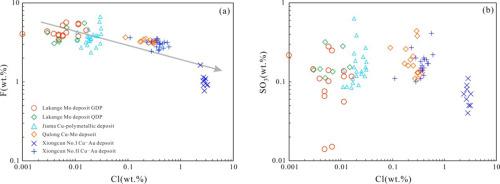Our official English website, www.x-mol.net, welcomes your
feedback! (Note: you will need to create a separate account there.)
Genesis of the Lakang'e porphyry Mo (Cu) deposit, Tibet: Constraints from geochemistry, geochronology, Sr-Nd-Pb-Hf isotopes, zircon and apatite
Lithos ( IF 2.9 ) Pub Date : 2021-01-01 , DOI: 10.1016/j.lithos.2020.105834 Pan Tang , Juxing Tang , Ying Wang , Bin Lin , Qiufeng Leng , Qizhi Zhang , Liang He , Zebin Zhang , Miao Sun , Chunneng Wu , Jin Qi , Yixuan Li , Shunjun Dai
Lithos ( IF 2.9 ) Pub Date : 2021-01-01 , DOI: 10.1016/j.lithos.2020.105834 Pan Tang , Juxing Tang , Ying Wang , Bin Lin , Qiufeng Leng , Qizhi Zhang , Liang He , Zebin Zhang , Miao Sun , Chunneng Wu , Jin Qi , Yixuan Li , Shunjun Dai

|
Abstract The Lakang'e porphyry Mo (Cu) deposit, intermediate to large in size, is located in the eastern part of the southern Gangdese metallogenic belt. It is associated with a Miocene granodiorite porphyry (GDP). The alteration styles are mainly potassic and phyllic alteration, with minor argillic, chlorite, and carbonation alteration. In this study, we present whole-rock geochemical compositions, zircon LA-ICP-MS U-Pb data, zircon Hf isotope analyses, and zircon and apatite major and trace element compositions for the ore-bearing GDP and postmineralization quartz diorite porphyry (QDP) to constrain the formation of the Lakang'e Mo (Cu) deposit. The ore-bearing GDP, with a zircon U-Pb age of 13.83 ± 0.20 Ma, was intruded after mineralization by the QDP, which was emplaced at 13.00 ± 0.16 Ma. The GDP and QDP are high-K calc-alkaline series rocks with adakite-like features characterized by high contents of K2O and Al2O3, high Sr/Y ratios, strongly fractionated REE patterns, LILE enrichment, and HFSE depletion. The GDP and QDP have relatively low (87Sr/86Sr)i values (0.7051–0.7054) and high eNd(t) values (−0.87 to 0.59). Zircon grains from the QDP have high eHf(t) values (7.0–9.6), while zircon grains from the GDP show large eHf(t) variations ranging from −4 to 9.6, indicating that the magma source of the ore-bearing GDP included more continental crust than that of the postmineralization QDP. The zircon Ce4+/Ce3+ and Eu/Eu* ratios and apatite Mn and SO3 contents indicate that the postmineralization QDP had higher oxygen fugacity than the ore-bearing GDP. The oxygen fugacity of the ore-bearing magma present during apatite crystallization (generally below the Ni-Ni-O (NNO) buffer), was lower than that present during zircon crystallization (above the hematite-magnetite (HM) buffer). The F, Cl, and S contents in apatite show that the GDP and QDP were F and S rich and that the GDP had a higher F content than the QDP. A high oxygen fugacity, a F- and S-rich magma and a Mo-rich crustal source were the key factors for the formation of the Lakang'e porphyry Mo (Cu) deposit.
更新日期:2021-01-01











































 京公网安备 11010802027423号
京公网安备 11010802027423号